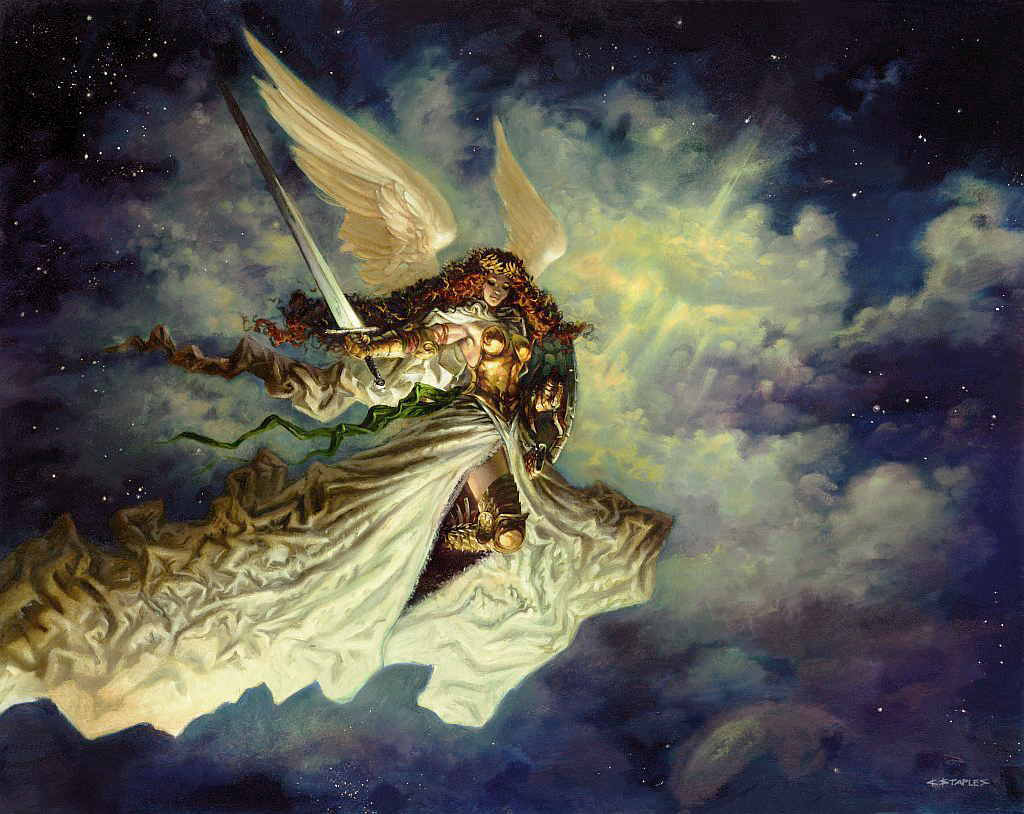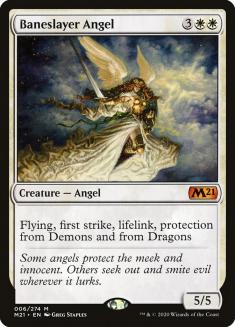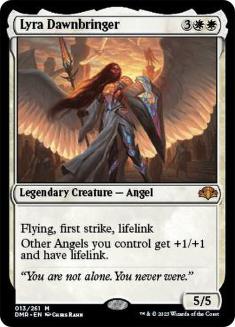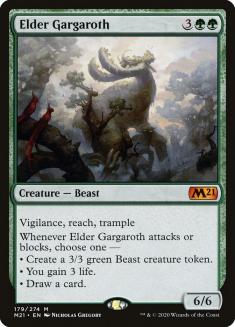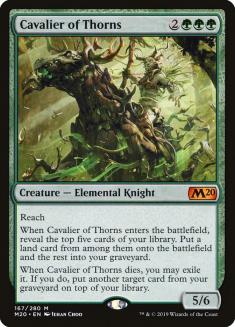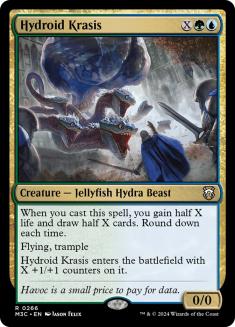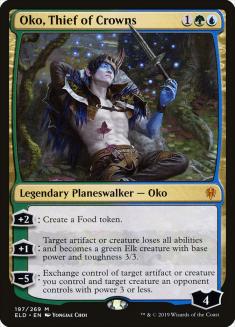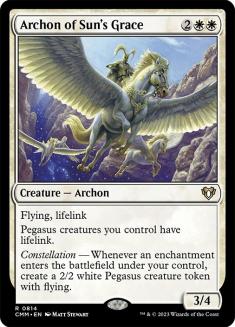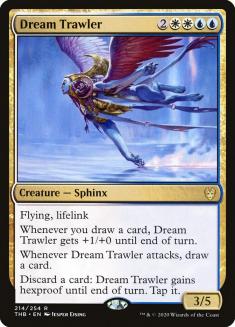The year is 2009. A world-historic global recession has just begun. A young Taylor Swift battles Lady Gaga for singles chart supremacy. Amidst these high stakes, Magic is planning to reinvent itself.
Magic 2010 gave a new mission to the Core Set, previously an introductory product for newer players and a dumping ground for reprints that would never be sanctioned under modern design processes. The summer preview season was rarely a source of excitement and more of a chance to place bets on which late-1990s lock piece would ruin games for years to come (as anyone still losing to Ensnaring Bridge, smuggled into Modern via 8th Edition, can testify). The revamped Magic 2012 Core Set not only overhauled the basic rules of the game (try explaining to an Arena-only player what “damage on the stack” meant without aging ten years!) but featured appealing new cards that didn’t have to be tied thematically to the latest plane or storyline. Its headline act has embarked on a comeback tour:
This card provoked cartoonish eyeballs-on-stalks reactions when it was previewed. R&D had publicly committed to redressing the imbalance between spells and creatures for some time but hadn’t quite figured out how. Baneslayer Angel was a clear statement about the game’s future direction. Magic would be much more accessible when the cards that looked good were good – when the innocuous card draw spell in every set wasn’t automatically better than the flashy mythic Angel, when you could justify playing the Demons and Dragons that Baneslayer Angel holds off in the skies.
This new design philosophy led to Baneslayer Angel but also created the conditions in which it could flourish. A finisher like this would never be good against combo or control no matter how many keywords crammed into its text box but was an ideal trump against aggressive decks and the increasingly creature-centric midrange decks. As planeswalkers cemented their place at the heart of competitive Magic, Baneslayer Angel was well-suited to both attacking planeswalkers and defending your own. If the game is about playing to the battlefield and winning through combat, Baneslayer Angel isn’t just a useful piece of the puzzle – it can be the whole puzzle:
Creatures (24)
- 3 Meddling Mage
- 4 Mulldrifter
- 1 Reveillark
- 4 Vendilion Clique
- 4 Glen Elendra Archmage
- 4 Knight of the White Orchid
- 4 Baneslayer Angel
Lands (21)
Spells (15)

This deck only popped up in the final days of a dying format and therefore never got the credit it deserved for its visionary design. Dan Gardner and the Orsini-Jones brothers realized that one half of the format couldn’t beat an uncontested Baneslayer Angel and the best cards at preventing that contest – Meddling Mage, Vendilion Clique, and Glen Elendra Archmage – were excellent against the other half pairing their own Baneslayer Angels with Cruel Ultimatum or trying elaborate nonsense with Heritage Druid or Time Sieve.
Baneslayer Angel carried enough weight against aggressive strategies that everything else could focus on keeping up with Reflecting Pool decks fielding the format’s best cards. It also offered a realistic one-card gameplan against Faeries, the thorn in the side of previous Reveillark decks since Morningtide. When all else fails, just protect the queen.
Gardner’s Angels came close to defending his title the following year in a more conventional Azorius Control shell:
Creatures (8)
Planeswalkers (8)
Lands (26)
Spells (18)

Here, Baneslayer Angel posed a classic dilemma to faster decks: leave in otherwise dead removal that’s a virtual mulligan against a normal control draw, or take it out and forfeit most games against an Angel. Baneslayer Angel wasn’t the first or last creature used for this tactic but remains one of the best examples of it across many formats. What can challenge the queen if there’s nothing to protect her from?
Creatures (30)
- 4 Birds of Paradise
- 3 Rafiq of the Many
- 4 Rhox War Monk
- 4 Noble Hierarch
- 1 Thornling
- 4 Knight of the Reliquary
- 4 Baneslayer Angel
- 4 Lotus Cobra
- 2 Rampaging Baloths
Lands (27)
Spells (3)
Sideboard

If you can’t protect the queen, you can always crown another. Base-Selesnya creature decks in this era had an embarrassment of riches for top-shelf threats and could hope to overload the powerful but conditional removal in the format. Zvi Mowshowitz Bant Mythic deck from Pro Tour San Diego took this idea to its natural conclusion – every spell can either win the game on its own or accelerate into the ones that can, forcing the opponent to have the right interaction in a narrower time frame.
Fast-forward to 2018. Rampaging Ferocidon is dominating the singles chart and Drake is banned in Standard – or something like that. Dominaria previews are in full swing and among the shiny new toys are updates and callbacks to old favourites:
It was a sign of how much had changed that we had a Baneslayer Angel that was meaningfully better in several ways and nobody seemed to care. After some early success, Lyra Dawnbringer was soon relegated to the role of sideboard switch-up without its older sister’s maindeck stardom. Compare Gardner’s Azorius Control deck to control expert Greg Orange’s winning Standard list from Pro Tour 25th Anniversary:
Creatures (1)
Planeswalkers (4)
Lands (26)
Spells (29)

While Gardner had to prepare for one of the most diverse Standard formats of all time, Orange aimed at a narrow format dominated by Rakdos Aggro and Mono-Red Aggro – natural prey for Lyra Dawnbringer! Nevertheless, Lyra was not a justifiable maindeck card – in part because it no longer represented a serious threat outside this specific context. As Magic 2021 gets ready to release the hounds, I’ll let Patrick Sullivan explain why not every Dog is a good boy:
Sometimes what happens is they kill it and you’re actually behind – they used a Doom Blade and cast a Divination. The range on the card going anywhere from bad (because it lost value on the way) to ‘I won the game’ and all the things that happen in the middle – that’s really good, that’s really replayable… Ravenous Chupacabra is the exact type of card that makes sure Baneslayers can’t show up in decks and Standard is already too long on the Baneslayers not being good enough to play in decks…
Wouldn’t it be cool if [Azor, the Lawbringer] was good enough to play? You play it and cross your fingers hoping to untap and if I untap it’s awesome and if my opponent has a particular answer it’s actively bad for me. That’s drama and tension in gameplay. Instead, of course I’m playing with Torrential Gearhulk. I’m not going to commit something to the table on my main phase that requires me to tap out and doesn’t generate immediate value. Why would I ever do that? I really wish we were sculpting a world where things like [Azor] were the finisher you wanted and not Torrential Gearhulk.
This argument from January 2018 looks more relevant than ever in what people tell me is June 2020. To borrow an apt distinction from Patrick Chapin – buried deep in the middle of a totally unrelated multi-part series, as all seminal theory should be – Standard is about Mulldrifters, not Baneslayers. More specifically, the current Standard is awash with “Titans” that rival their namesakes – creatures with bodies and abilities imposing enough to demand an answer that also make one-for-one removal a losing proposition.
We have the best Doom Blade of all time by many metrics in Heartless Act, but is it even good against the actual titan of Standard in Uro, Titan of Nature’s Wrath? How happy do you feel shooting a Hydroid Krasis or Woe Strider? The Doom Blades that can keep up with these cards already have Divinations stapled to them, creating an arms race where any one card must promise more cards to even enter the discussion. Alternatively, this “immediate value” can mean an impact on the battlefield that undercuts this arms race by threatening to end the game – Glorybringer for Sullivan; Winota, Joiner of Forces or Questing Beast (boasting a more random assortment of abilities than Baneslayer Angel could dream of) for us.
It’s no accident that both Patricks use Baneslayer Angel to illustrate their point, but the same logic applies to every equivalent card that catches the eye during preview season and inevitably fails to make its mark. Baneslayer Angel is Doom Whisperer is Luminous Broodmoth and Nightmare Shepherd, which is also Aurelia, Exemplar of Justice or a God-Eternal of your choice or any plucky hopeful that appears in Core Set 2021…
Teferi, Time Raveler’s stifling effect on Standard is well-documented – it’s an impressive rarity for a card to render obsolete an entire class of creatures and a wide swathe of spells at the same time, but Core Set 2021‘s main character is up to the task. This isn’t as relevant for Baneslayer Angel, which doesn’t pretend to be good against the decks that get to run Teferi, but it’s another nail in the coffin.
Effects that bounce a more expensive creature while leaving something behind are natural gatekeepers for Baneslayers – Jace, the Mind Sculptor and Reflector Mage consigned many perfectly good creatures to permanent obscurity. Vapor Snag played the same role in Azorius Delver, which capitalized on the tempo gained in that exchange to apply pressure; Brazen Borrower offers bounce and pressure in the same card.
This pressure turns bounce effects into Doom Blades by removing opportunities to recast the threat, but this principle is no longer limited to aggro-control decks – the threats used across the spectrum in Standard put you ahead far enough and quickly enough that this one turn is often all you need. The Mythic strategy of presenting one threat each turn until something sticks is no longer reliable.
While Teferi, Time Raveler will become a part of Standard history in a few months, every Baneslayer aspirant must still watch as Elspeth Conquers Death. As we learned in the past two iterations of Standard, the only thing that stops a bad guy with an Elspeth Conquers Death is a good guy with an Elspeth Conquers Death – a creature that plays right into its hands has no role in that fight.
Size matters – Baneslayer Angel is no longer the gold standard for midrange creatures. The Simic staples from the past eighteen months outclass Baneslayer Angel all the way up the curve with much less risk. Cavalier of Thorns in particular looks like a cruel joke from a designer with the patience to wait a year for the perfect punchline. In addition to beating Baneslayer heads-up, each of these “Titans” ramps towards or digs for other cards that go over the top of a middling 5/5.
As Ari Lax said, Ugin, the Spirit Dragon will define Standard yet again. If it’s any consolation, these green cards bullying Baneslayer out of the format also line up horribly against Ugin – when they aren’t helping to cast it a turn or more ahead of schedule.
In the bizarro world where we are still allowed to play Oko, Thief of Crowns and leave the house, there are young gamers who watch their pack-fresh Baneslayer Angel become an Elk at Friday Night Magic and never touch a Magic card again.
If Baneslayer Angel doesn’t do the job in midrange mirrors, maybe it’s just a tool for beating aggressive decks – there’s no shame in that! On closer scrutiny, this picture looks bleak too. While the current edition of Mono-Red Aggro is vulnerable to a large lifelink creature, lacking burn to win outside combat or cards like Ahn-Crop Crasher to remove a blocker on a crucial turn (though the hyperaggressive Cavalcade of Calamity lists can win before Baneslayer Angel hits the battlefield or via Cavalcade triggers before it can block); the other “aggressive decks” play more like aggro-combo decks that can go over or through even the best blocker.
Jund Sacrifice can shoot down an Angel with Mayhem Devil triggers, overwhelm it with Bolas’s Citadel, negate the lifegain by sacrificing the blocked creature to Witch’s Oven or Woe Strider, or simply devour it with Priest of Forgotten Gods. Boros Cycling can Zenith Flare an Angel – or its owner! – if it doesn’t already have a larger Flourishing Fox. Simic Mutate – a reach theme deck in disguise – can make an Arboreal Grazer, Stonecoil Serpent, or Gemrazer a 6/6 with Auspicious Starrix and Illuna, Apex of Wishes or trample over for massive amounts of damage thanks to End-Raze Forerunners. When you can’t even go toe-to-toe with a Sloth, it’s time to hang up the gloves and get out of the ring.
Baneslayer Angel has a limited remit in Standard. Who might be interested in it?
Creatures (2)
Planeswalkers (6)
Lands (25)
Spells (27)

A key innovation in Paulo’s Worlds-winning list was the move away from Dream Trawler and towards Archon of Sun’s Grace. Against other blue decks that might also have a semi-transformational sideboard plan, Archon of Sun’s Grace is a cheaper threat to deploy early and defend with counters or stymie the opponent’s aggression while dodging Mystical Dispute. Archon also curves well into Elspeth Conquers Death when both players are tapping out to exchange haymakers.
Paulo identified that Archon “often overperformed compared to Dream Trawler if your opponent was aggressive” and it retains that relative efficiency over Baneslayer Angel. If you untap (on the turn you would otherwise be casting the Angel), any cheap enchantment lets you develop a battlefield that rivals the impact of an Angel while having mana available for other things – if you don’t get that extra turn or your Archon dies, Angel is unlikely to have changed the outcome. Azorius Control may be more keen on Archon’s smoother play patterns or Dream Trawler’s resiliency over Angel’s middle ground – assuming Shark Typhoon hasn’t changed this dynamic already.
The Bant Ramp decks having early success in this “post”-companion world may be an easier sell. These decks are tailored towards blue mirrors but are vulnerable to sustained aggression – Bant can accelerate into an Angel via Growth Spiral or Uro and rely on it to stabilize the game in a way that other five-drops like Elspeth Conquers Death and Nissa, Who Shakes the World (or – previously – Yorion, Sky Nomad) cannot.
One of the toughest aspects of any competitive endeavour is knowing when to retire. Staying on past your prime only to be upstaged by some arrogant upstart can damage your legacy – fans are fickle and remember the recent lows over the distant highs. I want to believe I’m wrong and that Baneslayer Angel’s still got it. I’m not optimistic.

